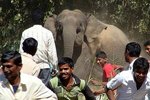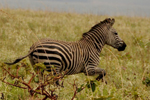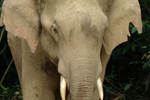
Confiscated elephant parts from poachers. Photo by: Nuria Ortega.
For the past five years, Spanish biologist Luis Arranz has been the director of Garamba National Park, in the Democratic Republic of Congo (DRC).
Arranz and a team of nearly 240 people, 140 guards among them, work to protect a vast area of about 5,000 square kilometers (1,930 square miles) of virgin forest, home to a population of more than 2.300 elephants that are facing a new and more powerful enemy.
The guards are encountering not only bigger groups of poachers, but with ever more sophisticated weapons. According to Arranz, armed groups such as the Lord’s Resistance Army from Uganda are now killing elephants for their ivory.
INTERVIEW WITH LUIS ARRANZ
Mongabay: Is there a new and more violent stage in the killing of elephants for their ivory, with the participation of groups with more sophisticated weapons?
Luis Arranz: The problem is that the price of ivory has gone up a lot, which means that people are willing to do anything to get it. Until now we have fought against groups of poachers that are not very numerous or well armed (a group of 6 people with 2 or 3 weapons). But now we see groups of over 30 people that carry heavy weapons like machine guns.
Mongabay: There has been speculation that armed groups are behind some of the killings.
 Luis Arranz. Photo by: Nuria Ortega. |
Luis Arranz: It is not only speculation. Up until recently the poachers were mainly locals or even from Sudan.
The Lords Resistance Army (LRA), from Uganda, has been in DR Congo for five or six years and we think it hadn’t killed elephants. But now we know it has.
The LRA has kidnapped thousands of children to force them to work as soldiers or sex slaves. Every time we have a shooting with them some children try to escape.
Those children have told us that this year the LRA has orders from Joseph Kony, its leader, to kill elephants and send him the ivory.
A girl told us that she saw several times groups of people leaving with 10. 15, 20 tusks to take the ivory to Kony.
Mongabay: How many guards work in Garamba?

Wildlife rangers for Garamba National Park. Photo by: Nuria Ortega.
Luis Arranz: The park is about 5,000 square kilometers. We have about 140 guards. Amongst them 30 or so are not very young, they are in their sixties, and don’t do patrols. They try to keep working as long as they can because there is no pension system.
Some guards always stay to protect the headquarters of the park because we were attacked in 2009 and 16 people were killed.
We have guards with many years of experience, like Alexandre Tamoasi or Agare. They are really the ones that are allowing the park to keep existing in spite of all the problems.
Tamoasi and Agare have had many shooting with poachers, but they never turn back.
Mongabay: Are you considering using more sophisticated weapons?
Luis Arranz: The guards risk their lives as most encounters with the poachers end in shoot outs. We have very old weapons (mostly AK 47s) and in disrepair and we have many problems getting ammunition so we can not do target practice for training. This is the first thing we need, enough weapons and ammunition.
Night vision equipment could help to discover the evening camps and drones would be a possibility but there is no decision yet. Now we have a Cessna 206 and a microlight to fly over the park. Poachers have shot at us.
Mongabay: Could you give us details of the incident in April when 22 elephants were killed?

Elephant slaughtered by poachers for its ivory. Photo by: Nuria Ortega.
Luis Arranz: One of the elephants with radio collars stopped moving and we went to see what had happened. We found a group of five elephants, three adults and two calves with their tusks and genitals removed. They were together, the adults protecting the calves, which is quite rare for elephants as they run when they hear shots.
Another thing that struck us was that around these elephants there were many footprints of people but we couldn´t find any leading to or from the place.
Although this had never happened, we suspect they might have been killed from a helicopter. In total 22 elephants were killed in several groups, all of them on the same day.
We recovered some skulls and found that in each case the bullet had entered from the top of the head.
A few days later we saw a military helicopter flying very low over the park and no one has been able to tell us what that helicopter was doing there.
Mongabay: What is is a typical day at work for you?
Luis Arranz: In my work there is no typical day, each day is different as new problems arise constantly.
I fly with ultralight in the morning, to see what is happening in the park and let people know that we are there.
In Garamba, beyond the protection of the park, we carry out research and also try to involve people living around the park, building schools, hospitals, wells.
I spend a lot of time dealing with employees, local authorities, the authorities in Kinshasa and the people who give us money.
Mongabay: What are the main challenges in Garamba?

Two elephants in Garamba National Park. Photo by: Nuria Ortega.
Luis Arranz: Garamba is very large indeed and almost impossible to protect fully. We track some elephants with radio collars to find out where they move throughout the year, in the rainy season, when they leave the park.
In previous years we were losing six or seven elephants a year, so far this year we have lost 50.
We must improve the training of the guards and recruit more and provide the necessary equipment, which includes weapons and ammunition.
Mongabay: What led you to this work?
Luis Arranz: When I graduated in Spain as a biologist it was very difficult to do field work, I didn’t want to work in an office and always wanted to work in Africa.
This was in 1980 and since then, except for five years I spent in South America (Bolivia, Brazil and Venezuela in particular) I have always worked in conservation in Africa.
First I spent six years in Equatorial Guinea, then in South America, two years in Angola, eight in Equatorial Guinea again directing the Monte Alen National Park, seven years in the Zakouma National Park in Chad and now I have been in Garamba for five years.
Most projects were funded by the European Union. In Garamba also the main donor is the EU but we are also funded by Spain. We are lucky as there are still some people there that really understand the problematic nature of conservation in Africa. In 2007 I was called by the African Parks Foundation, which is a non-profit organization that takes on direct responsibility for the rehabilitation and long-term management of national parks, in partnership with governments and local communities, to work in Garamba.
The truth is that of all the places I’ve been this is by far the most difficult for security issues but also because of logistics since it is very isolated.
I’m here because I like it, of course, but also because Garamba is a special place that will disappear if no one protects it. The government of DR Congo has no money to fund the park, and if the European Union stopped funding and we left, in one year there would not be any elephants, or hippopotamus left.
In Zakouma we went from 3,800 elephants in 2006 to about 400 now. It has been a real carnage. The same thing could happen in Garamba.
Before, in the sixties, Garamba had one of the largest populations of white rhino, there were about 1,200, now there is not a single one left.
We work trying to keep it until the situation changes in the country and the park can be managed like others in Africa. If the animals are gone and people settle here, it will be impossible to rehabilitate the populations of elephants. This is a race against time.
Mongabay: You have said that the trade in ivory is similar to drugtrafficking.

Garamba wildlife rangers. Photo by: Nuria Ortega.
Luis Arranz: As I said before, if demand continues to rise and more is paid for an elephant tusk there will be people willing to kill and die for it.
At our level we can not stop this slaughter, it is completely impossible. We can try to reduce it, but poachers increasingly come better prepared.
I think we should ban the ivory trade completely. No one needs ivory and now those who die are the guards and poachers that earn very little and never leave the poverty in which they live.
Now they are paying $200, $300 or $500 US dollars for each kilo. And I have seen tusks of about 40 kilos.
They will keep coming with more people, and helicopters or whatever it takes. Either the trade is completely banned or it will be impossible to combat it.
 Elephant herd. Photo by: Nuria Ortega. |
The ivory problem is not new. In the time of King Leopold the Europeans wanted the ivory, then the Americans, and now the main market is China.
The problem is that in China there are over 1,300 million people and if half of them wants half a kilo of ivory no elephants in the world would be enough.
The solutions is to convince not only China, but also other Asian countries, Europe, and the US that the ivory trade is finishing elephants and has to be banned completely.
Mongabay: What can readers do to help protect elephants?
Luis Arranz: The first thing of course is to not buy ivory under any circumstances. No one needs ivory, there are substitutes. But for a sculpture or a figurine on top of a TV, elephants and people are dying.
We spend millions in artworks and museums and no one questions this, but we are incapable of conserving what we already have.
I have a huge respect for elephants. In spite of all the attempts to finish them they are still here.
Each elephant is in itself a wonder, six or seven or eight thousand kilos of a perfect animal, that takes 22 months to be born.
I believe that there are few things more beautiful in this world as watching a group of 400 elephants moving through the savanna. It is increasingly difficult to see this because we are killing them. We are finishing with the elephants.

Large elephant herds still survive in Garamba, but for how long? Photo by: Nuria Ortega.
Related articles
Authorities confiscate 600 dead elephants’ worth of ivory in Hong Kong
(10/22/2012) Hong Kong authorities have confiscated two massive shipments of elephant tusks, totaling 1,209 tusks, stemming from Kenya and Tanzania. Representing over 600 poached elephants, the shipments are estimated to be worth $3.4 million on the black market. African elephants are being decimated for their tusks in recent years with heavily-armed and well-connected poachers—backed by criminal syndicates—killing off whole herds in some cases.
Appreciating elephant individuality: a new approach to preventing conflicts with humans

(10/09/2012) To prevent conflicts between humans and elephants in developed areas, a new study shows there is much to learn from analyzing Asian elephant behavior at the individual level as opposed to population studies. Researchers have traditionally interpreted elephant behavior at the population level, looking for behavior patterns among elephants of similar ages, group sizes, and genders. Today, field researchers in India are studying elephant behavior at the individual level. Their goal is to appreciate the idiosyncrasies of individual elephants in the hopes of predicting their behavior. Nishant Srinivasaiah, of the Tata Institute of Fundamental Research and lead author of the study, told mongabay.com that it is vital “to get to know our elephants more intimately than ever before and, more importantly, to shift our focus from a population to include its individuals as well.”
Conflict and perseverance: rehabilitating a forgotten park in the Congo

(09/19/2012) Zebra racing across the yellow-green savannah is an iconic image for Africa, but imagine you’re seeing this not in Kenya or South Africa, but in the Democratic Republic of Congo (DRC). Welcome to Upemba National Park: once a jewel in the African wildlife crown, this protected area has been decimated by civil war. Now, a new bold initiative by the Frankfurt Zoological Society (FZS), dubbed Forgotten Parks, is working to rehabilitate Upemba after not only decades of conflict but also poaching, neglect, and severe poverty.
Learning to live with elephants in Malaysia

(09/18/2012) Humans and elephants have a lot in common: both are highly intelligent, intensely social, and both are capable of having a massive impact on their local environments. Given their similarities, it might not be surprising that elephants and human have often run afoul of one another. Conflict between these two great species has probably been going on for thousands of years, but as human populations have grown dramatically, elephant populations have been crippled and forced into smaller-and-smaller pockets. No-where is this more true than in Southeast Asia.
Wildlife trade bans may be worsening trafficking of some species, argues paper
(09/18/2012) While founded with good intentions, wildlife trade bans may in some cases be worsening the plight of some endangered species, argues a commentary published in the journal Tropical Conservation Science.
Religious fervor drives elephant slaughter
(09/14/2012) The legal ivory trade is failing to protect elephants which are being slaughtered en mass across the African continent to meet demand for religious trinkets, argues a new investigative report published in National Geographic by Bryan Christy.
Yuppies are killing rhinos, tigers, elephants
(09/07/2012) Yuppies, not elderly rural consumer, are driving the trade that is decimating some of the world’s most iconic endangered species, including tigers, elephants, rhinos, pangolins, and bears, said experts meeting at a workshop in Vietnam.
Picture of the day: Yao Ming with baby elephant orphaned by ivory trade
(08/27/2012) Former NBA Basketball player and Olympian, Yao Ming is taking his first trip through Africa in order to see the on-the-ground impacts of the black-market ivory and rhino trades in East Asia. Ming, who stands 7-and-a-half feet (2.3 meters), has become not only well-known for his athletic prowess, but also his devotion to endangered wildlife.